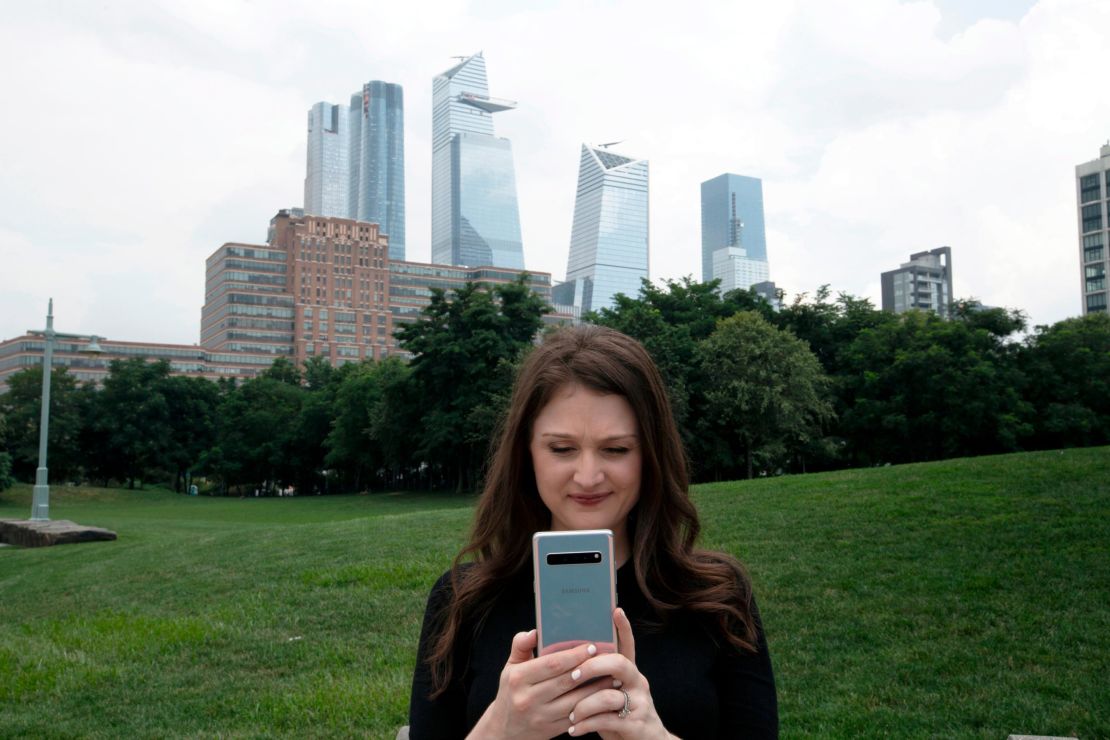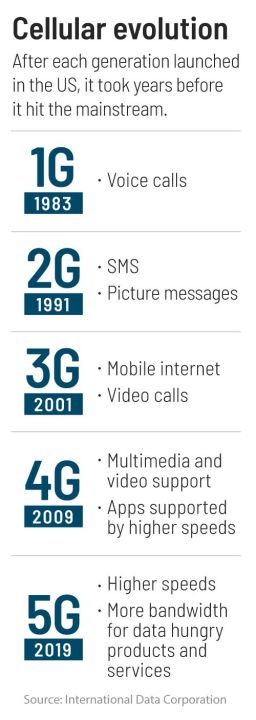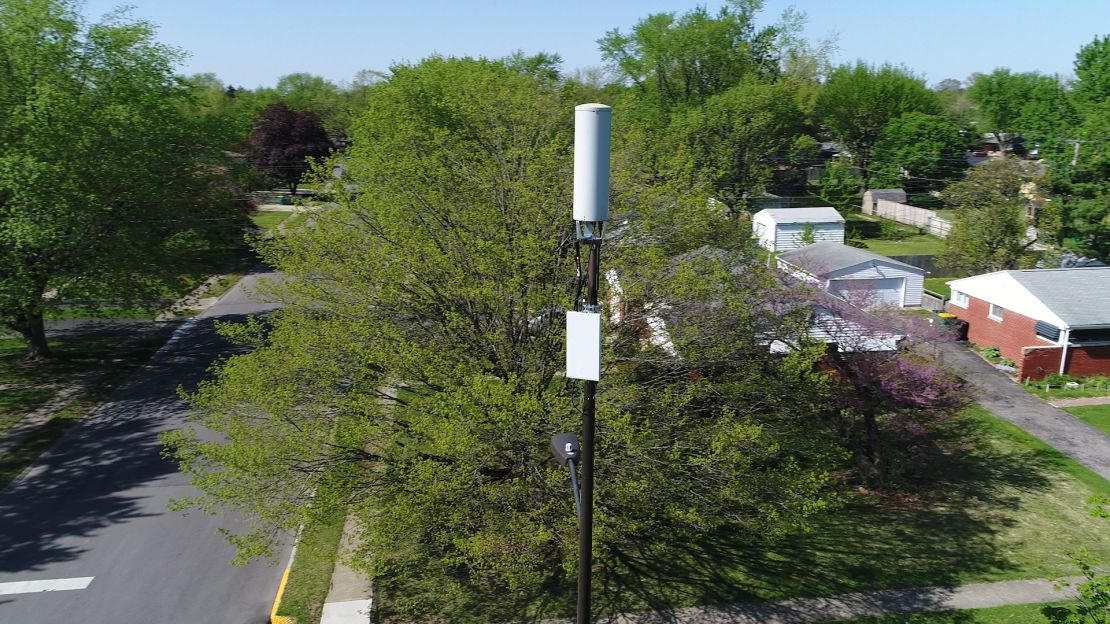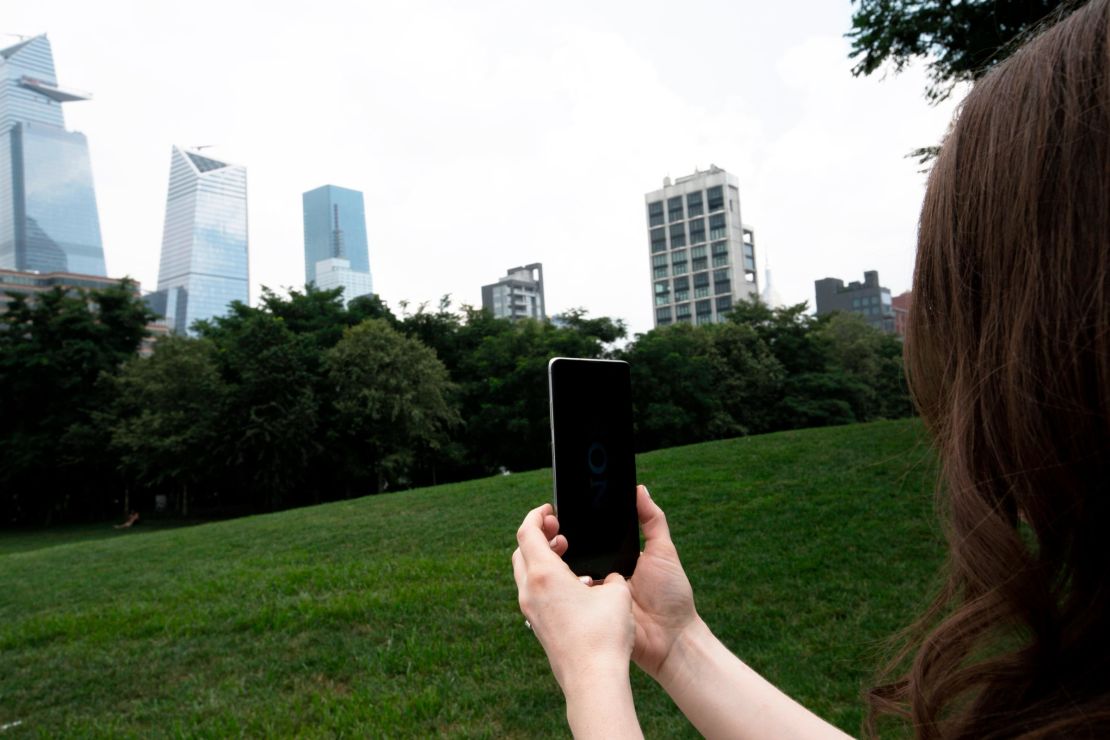Self-driving cars. Robotic surgeries. Toothbrushes that detect when you’re sick.
This is the future 5G technology promises in less than a decade’s time; internet connections so fast they’ll support an entirely new way of life.
But for now, I’m standing on an avenue in downtown Chicago waving my Samsung Galaxy 5G smartphone around to find coverage that’s not blocked by the tree to my left.
I finally take a few steps back from the lamppost, adorned by a hard-to-miss, clunky black antenna, and bam, my Netflix download begins: a complete download of a two-hour film in less than 10 seconds — in stark contrast to the seven-or-so minutes it’d typically take on 4G.
This was my experience testing the newly launched Verizon 5G network in Chicago last month. When it worked, it really worked, often hitting over 1 gigabit per second in speed tests — an incredible feat for a piece of technology that fits in your pocket. 4G LTE in the United States averages about 35 megabits per second. 5G, the fifth generation of cellular network technology, is nearly 30 times faster — and about 10 times faster than the average American home broadband speed.
But 5G isn’t just about speeds on smartphones. Other technologies will be made possible with its ability to handle much more bandwidth, allowing the data from sensors, thermostats, cars and robots to work together in real time.

Think of it like this: If 3G is a two-lane highway and 4G is six lanes, 5G will turn it into 12 lanes. It’ll handle significantly more traffic and bandwidth with zero latency, a word that refers to immediate response times for data transfers — will allow self-driving cars to process all the information they need to make life-or-death decisions in the blink of an eye, or the health care industry to help power the next generation of telemedicine and robotic surgeries. (A surgeon in China recently conducted a liver transplant on an animal from a location 30 miles away by controlling a robotic arm running on 5G. The same procedure on a 4G network would have increased the chance for mistakes).
Mobile carriers are pouring billions of dollars into 5G. The new networks and associated technologies are expected to add $17 trillion to the global GDP by 2035, according to ABI Research. But there will be a significant lag between 5G’s rollout and that financial impact. It’s not dissimilar to the 3G iPhone — an impressive piece of standalone technology that didn’t make a big economic impact until a year later with the arrival of the App Store. A few years after that, 4G paved the way for on-demand apps such as Uber, mobile video consumption on Netflix and FaceTime, real-time rerouting via Google Maps and social sharing on Instagram and Snapchat.
We’ve maxed out the 4G capabilities of what our phones can do, but 5G could offer a doorway into what’s next. However, carriers have a long way to go before they deliver on that promise.
My 5G network tests, often performed via the Speedtest app, were inconsistent. If I turned a street corner on Verizon, 5G went out of range — a major drawback to the high-frequency spectrum approach being adopted by some carriers. That technology delivers lightning-fast speeds but doesn’t cover wide areas, penetrate indoors and can be blocked by rain or, in my case, leaves.
Inside a Verizon store on Michigan Avenue, I looked out at the cellular radio equipment hanging on another lamppost 20 feet away, unable to get on the network from the other side of the glass window. It poetically captured the current state of 5G: The future was staring right at me but I couldn’t quite access it.
Rollout blues
Verizon was my first experience with 5G: I’ve since tested the networks for Sprint, T-Mobile and AT&T, CNN’s parent company. Each provided a different experience. My speed tests on AT&T dominated, reaching an impressive 1.6 Gbps in a Dallas park and downloading “Spider-Man: Into the Spider-verse” in 5 seconds. (Think of all the movies you could download in the 60 seconds you have on the tarmac before a flight takes off.)

I also tried Sprint, which uses a lower frequency for its 5G network, in Chicago. It was the most consistent in terms of coverage — I was able to duck into a Starbucks, turn street corners and hop into a car without dropping from the network. But its speeds were slower than some of the other networks; I downloaded a movie in about 15 seconds. (This is still mind-blowingly fast.)
Rollouts for past networks weren’t always pretty, resulting in calls dropped, spotty coverage and drained batteries. As Jon Stewart put it in 2011 on “The Daily Show,” “Those of us in the ‘iPhone community’ have sacrificed one thing for the ability to carry around every photograph we’ve ever taken, or song we’ve ever listened to, or home video, or compass. We have sacrificed the ability to make phone calls. For years, for years.”
Now the past could repeat itself. Upgrading tens of thousands of cell sites in the US to 5G will take six to eight years to catch up to 4G’s footprint, according to Dan Hays, executive advisor at consulting firm PwC.
“It’s an enormous program involving tens of thousands of people all over the country, and not everyone has the skill set to climb the towers to swap antennas,” he said.
5G, which uses similar equipment to 4G, operates on two main types of cell sites: large macro-cell sites that can be installed on towers or rooftops (or hidden in fake cacti and trees), where they are typically housed in enclosures like cabinets or a large closet; and small cells the size of a pizza box, which hang on a light pole, wall or ceiling inside of a building. The latter is a method already in use by 4G networks, but on 5G, it’ll move some functions to the cloud, Hays explained.
Eventually, many 5G cell sites will need to be closer together in areas previously covered by a single 4G cell. “Not all 4G cell sites are easily upgradable,” Hays said. “Some could be upgradable with as little as a software update while others may need to be replaced completely.”

You have 5G. Now what?
Even in the areas where 5G is already up and running, getting onto the network can be tricky. To start, you’ll need one of the few, pricey, 5G-compatible phones, such as the $1,300 Samsung Galaxy S10 5G or $999 LG V50 5G. (Some testers from the Wall Street Journal and PCMag reportedly overheated when the devices reached a certain temperature. I didn’t have similar issues).
When more devices start to offer 5G — and consumers organically upgrade to these new models — we’ll likely see a surge in adoption; that is, if the networks are up and running in more places by then. By 2024, Ericsson Mobility projects more than half of mobile subscriptions will run on 5G in the US. (Apple is expected to launch a 5G iPhone in the fall of 2020).
For now, one of the biggest challenges in testing 5G coverage is finding it. I was given a map from Sprint highlighting spots in downtown Chicago where I could pick up 5G. I seamlessly navigated neighborhoods without dropping off the network, envisioning what life will be like when I can download an entire TV season in the few seconds before my coffee order is ready. But without a map on hand in Dallas, I was left guessing which areas would give me 5G Sprint coverage (I was usually wrong).
In Chicago on Verizon, 5G worked well on main avenues but not on the side streets — the equipment hadn’t yet made it over to those blocks. On T-Mobile in New York City, I several times found myself automatically connected to 5G while wandering around different neighborhoods. But other times, I could see the carrier’s cell sites on buildings nearby and still struggled to get onto the network.
Different carriers, different approaches
The four major mobile carriers’ approaches to 5G vary based on the spectrum each company already owns. This is why Verizon can say its network is all about speed, Sprint promises continuity, T-Mobile wants to be nationwide first in 2020 and AT&T is doubling down on connecting businesses.
Wireless companies have traditionally used low-band spectrums for cell phone service because they travel farther and penetrate walls better than higher frequencies. But higher frequencies offer much faster speeds. The frequencies AT&T and Verizon, known as millimeter wave or “mmWave”, are using are significantly higher than Wi-Fi. It is the fastest and most responsive form of 5G but doesn’t travel far.
Sprint’s mid-band spectrum casts a much wider net of coverage, allowing 5G users the ability to access it both inside and outdoors. However, my tests on Sprint’s network often showed half the speeds of what I often saw on the high-band spectrum. (Sprint has committed to covering 11 million people with 5G by the end of the year.)
Meanwhile, T-Mobile is focused on deploying low-band spectrum, but in New York City, its network runs on high-band spectrum — a move that could allow the company to build out its existing infrastructure in the area to get its foot into the 5G race. If it merges with Sprint — a deal that was recently approved by the Justice Department — it’ll be that much closer to reaching its coverage goal.
Beyond phones
Narrowly focused on businesses, AT&T’s 5G network is only open to companies and developers, and not available to the general public (though it will be soon). But it’s already being used by Rush University Medical Center in Chicago to deliver near real-time remote healthcare monitoring and the ability to transmit large imaging files quickly. It aims to eventually support artificial intelligence to help patient care and augmented reality to train medical students.
Meanwhile, AT&T Stadium, home of the Dallas Cowboys, is the first stadium with 5G in the country, where beige high-frequency 5G antennas blend into the industrial, modern aesthetic of the football-shaped venue. The world’s most valuable sports franchise plans to give workers, such as parking lot attendants and food service staffers, 5G devices to make everything from in-seat hot dog deliveries to virtual reality fan activations even faster. In July, I performed a series of speed tests inside the stadium that brought in results close to what I experienced outside at the Dallas park, over 1 Gbps per second.
“We need to understand what 5G is and how it will enhance our fan experience,” said Matt Messick, chief information officer of the Dallas Cowboys. “We’re one of the first to start asking questions. It’s one thing to start talking about it then to have it and start testing it.”
Messick didn’t elaborate on what exactly to expect, but stadium-goers are competing with a limited pool of bandwidth; the ability to make calls, check the internet for stats and post videos to social media without lag times is as good of an incentive as any to offer fans in the stands.
Mo Katibeh, CMO of AT&T Business, envisions future cities not needing stop lights as self-driving cars automatically communicate with other connected vehicles nearby. Experts project this could become a reality as soon as 2026. “Everything will be interconnected and ‘talk’ to each other,” Katibeh said.
A ‘dose of reality’
5G is expected to have a major impact on the economy, but exactly how that will look is mostly unknown.
“Right now, job creation is all about the deployment of the network, such as from the tower climbers and equipment technicians,” said Hays, adding it could create a whole new economy just like the internet did.
5G could create up to 3 million new jobs across various industries in the US, from smart city development to robotics and food services, according to Accenture. But Hays called most projections around 5G “overly optimistic,” considering for now it’s only a faster version of 4G. “There is a dose of reality that needs to come when you talk about 5G,” he said.
Some of America’s 5G ambitions will confront the realities of red tape, costs and other practicalities. For example, some experts say millions of delivery drones could one day be supported by 5G coverage, but the networks today aren’t built to work 1,000 feet in the air. Augmented reality could come to car windshields, serving up turn-by-turn directions or even pop-ups of job listings as you drive by businesses. But because US states require glass replacement each time a rock cracks a window, it’ll be harder for insurance companies to agree to pay for new windshields.
“Technology development is certainly becoming more feasible, but the question of who will pay also remains,” Hays said.

Consumers aren’t looking to pony up for the benefits of 5G either. According to a recent PwC study, about two thirds of respondents said they weren’t willing to pay more for 5G than what they’re already spending on 4G. (More than half said they already pay too much for internet access). Verizon originally announced it would charge an extra $10 a month for 5G coverage, but has since delayed the additional charge for an undetermined amount of time.
Edward Oughton, senior research associate at the University of Oxford who closely studies 5G development, likened the technology to the Concorde, the high-speed turbojet-powered supersonic passenger airliner that flew at twice the speed of sound.
“[It] did not revolutionize global travel; the jumbo jet did,” Oughton said. “The technology is very fast but only a few wealthy users will be able to afford it at least initially — most of whom will be in urban and suburban areas.” He argued getting the cost per bit of data transfer down is key. “This is where the biggest productivity benefits will lie; not in faster access in cities,” he said.
All four major US mobile carriers declined to share how many people are currently using their 5G networks, but said they’re continually adding new customers. “Early users might be disappointed with 5G in the beginning as carriers work out kinks,” PwC’s Hays said. “Consumers should lower their expectations in the months and years ahead.”
I took his guidance ahead of my final 5G test with T-Mobile in New York City. The carrier’s 5G network wasn’t the fastest — it took me longer to download “Spiderman: Into the Spider-verse” on T-Mobile than any other network (about 38 seconds) — but my reaction reminded me how quickly we judge new technologies.
When I reached for my 4G phone hours later and a mere app took nearly five times as long to download, I had a newfound appreciation for 5G, even with its limitations.
It’ll inevitably produce headaches, with spotty service requiring expensive devices to access it — but eventually, we will look back on this time trying to remember what life was like without it.











